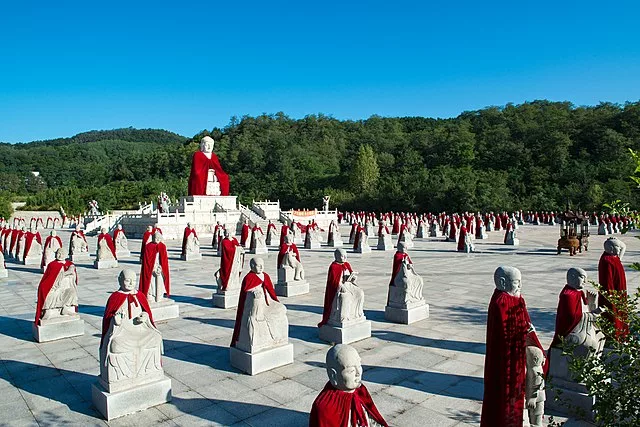The 3rd Noble Truth is Nirvana, the Cessation of Suffering by seeing through the illusion of ego and establishing that insight in meditation, on a permanent basis. This allows the arhat to remain in nirvana and not to take rebirth.
Table of Contents
Four Noble Truths simplified
| 4 Noble Truths in Buddhism | ||
| English | Sanskrit | key points |
| Life is Suffering | dukkha | 3 types – conditioned existence, attachment, all-pervasive |
| Origin of suffering is attachment | taṇhā | 5 skandhas, 12 nidanas |
| Cessation of suffering | Nirvana | Extinction of craving, realizing non-self, no rebirth |
| Path | Marga | Meditation, 8-fold path, non-returning |
Cessation of Suffering, 3rd Noble Truth

Cessation of suffering or dukkha has the meaning of leaving the round of rebirth, never to return. According to the Buddha, th less said about it, the better. Cessation of suffering, in essence, is seeing through the illusion of the singular, independent self. Overcoming the game of ego, one sees that it has no substantive reality.
Buddha with 500 arhats. Photo: DrewHeath
Knowing that, realizing that as experiential perception, the same way you realize you are human or you realize your name – at a very deep level, as reality perception, allows cessation. Not knowing your own name would never happen, it would be bizarre. Understanding it intellectually is one level, realizing it directly, knowing, perceiving, and living this way, are completely different.
Genuine Cessation of Suffering: 4 aspects
- Actual stopping of dukkha – it will never return
- Nirvana / cessation of suffering is peace
- It is superior to other meditative states and all states of birth
- ‘Definite emergence’ or exiting the round of samsara
Where is Nirvana? What is it?
Nirvana/nirodha is nowhere. It is not a place. The word translates literally as ‘blown out,’ or extinguished, referring to the burning pain that abides in the mind as the truth of suffering. All mental activity ceases, the blanket of existence is no longer being woven.
How to meditate like a yogi
and enter profound samadhi
The arhat signifies one who has attained this state. It is possible to attain it in this life, before death. This is nirvana with remainder, the remainder being the body. After death, it is nirvana without remainder. Then the person will not return.
Escaping the cycle of rebirth or samsara is the final goal. It is nirvana. Importantly, cessation of suffering is not complete enlightenment. The mindstream still has karma in the alaya. If the being takes rebirth at some point, then they will have to deal with their karma. Choosing not to take rebirth allows the karma to remain latent for as long as the arhat wishes.
How to meditate like a yogi
and enter profound samadhi
Bhikkhus, it is through not realizing, through not penetrating the Four Noble Truths that this long course of birth and death has been passed through and undergone… these have been realized and penetrated, cut off is the craving for existence, destroyed is that which leads to renewed becoming, and there is no fresh becoming.
The Buddha
Nirvana, cessation, is the goal in and of itself. From a Hinayana perspective, there is nothing further. The criteria for no longer taking rebirth are to extinguish the ‘three fires’ – passion, aggression, and ignorance. These three tendencies generate the karmic push that propels us to new rebirths.
Abhidarma
In order to do so, the practitioner must understand the Abhidharma – the Buddha’s psychological portrait of existent beings. Seeing the skandhas and meditating on their non-substantiality and impermanence directly. Also, he must meditate on the 12 nidanas, the chain of karma, seeing their operation in the mindstream. Of special import is the 7th nidana, craving, which leads to grasping. By releasing the craving before it transforms into grasping, the chain of karma is broken and the impulse to take rebirth is overcome.
You must work out your own salvation with great diligence, Ananda. I can only show the way.
The Buddha
Cessation in Mahayana
The Mahayana speaks of cessation as the non-abiding nirvana. In essence, this is the full enlightenment of buddhahood. Buddhas can return to appear in samsara to benefit beings. They are not caught in the samsaric mechanisms in any way whatsoever.
While arhat cessation overcomes the negative emotions, non-abiding cessation goes much further. The final veils of cognition are pierced and ‘omniscience’ is attained. The cognitive veils, the veils to knowledge, are the most subtle level of duality. Duality is perceiver and perceived. This veil is far easier to overcome in meditation. Movements and activities in life present enormous obstacles to it.
The Buddha is able to rest in action, within the Tatagathagharba. A Buddha is not pulled into the trap of samsara, and, resting in the buddha nature, perceives the totality of everything. This is enlightenment, called the Great Nirvana.
Secrets of Meditation for Anxiety
Like millions of people, you may have suffered from anxiety for years. Meditation, yoga, peaceful music – it never works. It takes too long, and it’s not stable. Why? Because peace is treated as a cause for freedom, but it’s not – it’s the result. The cause to free yourself from anxiety is completely different.
Click now to Overcome Anxiety for good.
faq
What is the third noble truth in Buddhism?
The third noble truth in Buddhism is the cessation of suffering, dukkha, based upon the path.
What is the third noble truth the cause of suffering?
The third noble truth is not the cause of suffering, but the cessation of suffering from the realization of not-self.
What is the Four Noble Truths third?
The Four Noble Truths: The third truth is the end of suffering by seeing the illusory nature of the ego.
What is the third noble truth for kids?
The third noble truth for kids is to stop trying to make yourself the center of the universe, but instead to think about what your ‘self’ really is.
What is the third noble truth to end suffering – one must end desire?
For the third noble truth to end suffering, one must end the desire for rebirth.
Conclusion of Cessation of Suffering
The 3rd Noble Truth, cessation of suffering, means to leave behind samsara, the karmic round of birth and death and never to return unwillingly. It overcomes the 3 poisons as the impulse to enter the wheel of existence. However, the Mahayana posits this is a lesser Nirvana, with Great Nirvana being more than simply extinguishment, but also union with the buddha nature itself.
How, then, does one get this? Through the fourth Noble Truth – the path.

May all beings be happy
May all beings be peaceful
May all beings be safe
May all beings awaken to the light of their true nature
May all beings be free







